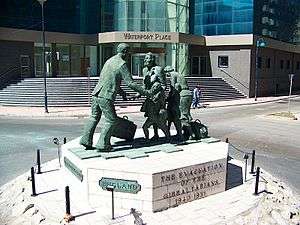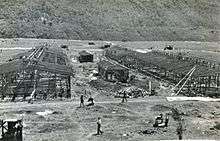Evacuation of the Gibraltarian civilian population during World War II

Part of a series on the |
|---|
| History of Gibraltar |
 |
| Timeline |
|
|
The evacuation of the Gibraltarian civilian population during World War II was an event which dramatically changed the lives of Gibraltarians.[1] The British Government's decision to enforce mass evacuation from the then Crown colony of Gibraltar, in order to increase the strength of The Rock with more British Armed Forces personnel, meant that most Gibraltarians (some for up to ten years) had nowhere to call home.[1] Only those civilians with essential jobs were allowed to stay. However, this event gave the entire community a heightened sense of "Britishness" by sharing in the war effort.[1]
Casablanca
In early June 1940, about 13,500 evacuees were shipped to Casablanca in French Morocco. However, following the capitulation of the French to the Germans in June 1940, the new Pro-German French Vichy Government found the presence of Gibraltarian evacuees in Casablanca an embarrassment and sought an opportunity to remove them.[1] That opportunity soon arose when 15 British cargo ships arrived under Commodore Crichton; they were repatriating 15,000 French servicemen who had been evacuated from Dunkirk.[1] Once the rescued servicemen had disembarked, the ships were interned until they agreed to take away all the evacuees.[1] Although Crichton was unable to obtain permission to clean and restock his ships (and contrary to British Admiralty orders which forbade the taking on of evacuees), when he saw the mass of civilians pouring through the dockyards, he opened up his gangways for boarding.[1] Just recently, (on 3 July 1940), the British fleet had destroyed a number of French warships at Mers el-Kebir, in order to prevent them being handed over to the Germans. The attacks killed thousands of French sailors and led to high tension between the British and the French,[2][3] which was evident when Gibraltarian families were forced at bayonet point by French troops to board, taking only what they could carry, leaving many possessions behind.
Back to Gibraltar
When the evacuees arrived at Gibraltar, the Governor, Sir Clive Liddell, would not allow them to land, fearing that once they were back on the Rock, it would be virtually impossible to evacuate them a second time.[4] Crowds gathered in John Mackintosh Square in the centre of Gibraltar as the news broke, speeches were made and two City Councillors accompanied by the Acting President of the Exchange and Commercial Library went to see Governor Liddell to ask that the evacuees be allowed to land.[5] After receiving instructions from London, a landing was allowed as long as the evacuees returned when other ships arrived to take them away from The Rock, and by 13 July the re-evacuation back to Gibraltar had been completed.[5]
London
British Conservative politician Oliver Stanley agreed to accept the evacuees in the United Kingdom, but he argued with Gibraltar over the number of people involved.[5] The Governor, he declared, had given the number of evacuees first as 13,000, then as 14,000 and finally as 16,000.[5] He asked for the situation to be clarified, stressing the shortage of accommodation in Britain and insisting that only 13,000 could be accepted, 2,000 of whom were to be sent to the Portuguese Atlantic island of Madeira[5] in July and August 1940. The situation, replied General Liddell on 19 July, "is that this is a fortress liable to heavy and immediate attack and there should be no civilians here, whereas there are 22,000.[5] The 13,000 was the number sent to Morocco, and more would have been sent had the situation there not altered."[5] In London the evacuees were placed in the hands of the Ministry of Health, and many were housed in the Kensington area.[5] Concern for them in Gibraltar mounted as the air raids against London intensified, coupled with the arrival of harrowing letters, describing the circumstances in which the evacuees were living.[6]
Madeira
Tito Benady, a historian on Gibraltar Jewry, noted that when some 200 Jews of the 2000 evacuees from Gibraltar were evacuated as non combatants to Funchal, Madeira, at the start of World War II, they found a Jewish cemetery (Jewish Cemetery of Funchal) that belonged to the Abudarham family. The same family after whom the Abudarham Synagogue in Gibraltar was named.[7]
On the 28 May 1944 the first repatriation party leaves Madeira for Gibraltar and by the end of 1944 only 520 non-priority evacuees remained on the island.[5]
In 2008, a monument was made in Gibraltar and shipped to Madeira where it has been erected next to a small chapel at Santa Caterina park, Funchal. The monument is a gift and symbol of ever-lasting thanks given by the people of Gibraltar to the island of Madeira and its inhabitants.[8]
The city of Funchal and Gibraltar were twinned on 13 May 2009 by their then Mayors, the Mayor of Funchal Miguel Albuquerque and the mayor of Gibraltar who had been an Evacuee from Gibraltar to Madeira Solomon Levy, respectively. The mayor of Gibraltar then had a meeting with the then President of Madeira Alberto João Jardim.
Jamaica


In September rumours were already circulating among the evacuees, and in Gibraltar, that the possibility of re-evacuating the Gibraltarians once more was being discussed, this time the destination being Jamaica, in the West Indies.[9] After much contention, it was decided to send a party directly from Gibraltar to the island, and 1,093 evacuees left for Jamaica direct, on 9 October, with more following later on.[9] However petitions followed and the demands were met, partly for strategic reasons and the lack of available shipping.[9] The situation at the end of 1940, therefore, was that approximately 2,000 evacuees were in Jamaica and a lesser number in Madeira, with the bulk of around 10,000 housed in the London area.[10] The camp that they were in was only designed to take 7,000, but the population of Malta had refused to be moved to Jamaica and the authorities wanted to use the unused capacity as a prisoner of war camp or as barracks for the local militia.[11] Discipline in the camp was quite strict with residents only being allowed out on the local trams between 8 a.m and 10 p.m. and local Jamaicans could be fined if they entered the camp. However, the camp enjoyed social events and gardening, but there was heated discussion with Gibraltarians who wished to not eat communally.[11]
Repatriation
The surrender of Italy in September 1943 lifted any possible objections to the return of the evacuees to The Rock.[5] As a result, a Resettlement Board was established in November, and at a meeting of the Board on 8 February 1944 repatriation priorities were finally agreed.[5] On 6 April 1944 the first group of 1,367 repatriates arrived on The Rock directly from the United Kingdom and on 28 May, the first repatriation party left Madeira, and by the end of 1944 only 520 non-priority evacuees remained on the island.[5]
In London, home-comers were making claims on the evacuees' wartime accommodation and 500 Gibraltarians were re-evacuated to Scotland and 3,000 to camps in Northern Ireland.[12] Although the Governor, Lieutenant General Sir Noel Mason-Macfarlane, fought valiantly on behalf of the evacuees and did not accept the lack of accommodation as a sufficient reason for the delays.[12] As late as 1947, there were still 2,000 people in Northern Irish camps.[12] The last of the evacuees did not see The Rock again until 1951.[12]
Legacy
Gibraltarians today remember the evacuation with a statue on one of the main roundabouts by Jill Cowie Sanders. In 2009, Gibraltar Members of Parliament went to the Church of Our Lady of Dolours in Fulham to thank the church for the support it had given to evacuees who were brought to London.[13] Over 100 babies were born in Jamaica and the camp that they occupied was converted into part of the University of the West Indies after the war.[11]
See also
- Military history of Gibraltar during World War II
- Military history of the British Commonwealth in World War II
Notes
- 1 2 3 4 5 6 7 Bond, pp. 97
- ↑ Mers-el-Kebir: A Battle Between Friends
- ↑ World War II: Attack on Mers el Kebir
- ↑ Bond, pp. 98
- 1 2 3 4 5 6 7 8 9 10 11 12 Garcia, pp. 15
- ↑ GGA, Evacuation 1940: General Mechanics of
- ↑ Yitzchak Kerem (2015). "Portuguese Crypto Jews". jewishwebsight.com. Retrieved 2015-12-20.
- ↑ www.love-madeira.com (accessed 13 December 2010)
- 1 2 3 Garcia, pp. 16
- ↑ Garcia, pp. 16–17
- 1 2 3 Brown, Suzanne Francis (2006). Mona Past and Present: The History and Heritage of the Mona Campus, University of the West Indies. University of the West Indies Press. pp. 10–11. ISBN 9789766401597.
- 1 2 3 4 Bond, pp. 100
- ↑ Gibraltar Day 2009 - special Mass - Church of our Lady of Dolours, accessed September 2012
References
- Finlayson, T.J. (1990). The Fortress Came First. The story of the civilian population of Gibraltar during World War II. United Kingdom: Gibraltar Books Ltd. ISBN 094846612X.
- Bond, Peter (2003). "The Third Century 1904-2004". 300 Years of British Gibraltar, 1704-2004. Gibraltar: Peter-Tan Publishing Co.
- Garcia, Joseph J (1994). Gibraltar: The making of a people; The modern political history of Gibraltar and its people. Gibraltar: Mediterranean SUN Publishing Co. Ltd.,.
Further reading
| Wikimedia Commons has media related to Evacuation of Gibraltar during World War II. |
- Finlayson, Thomas James (1991). The Fortress Came First: Story of the Civilian Population of Gibraltar During World War II. Gibraltar Books. ISBN 094846612X.